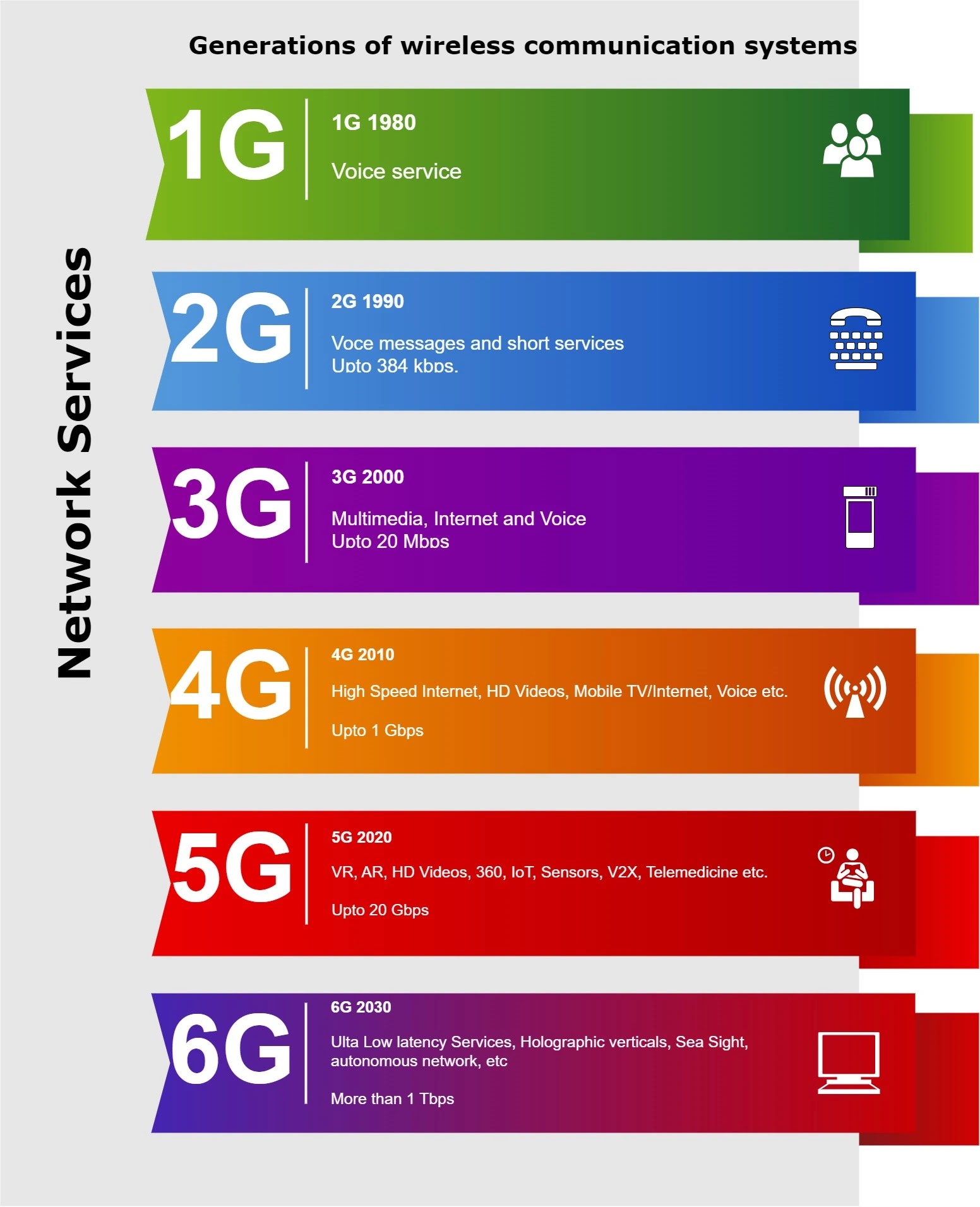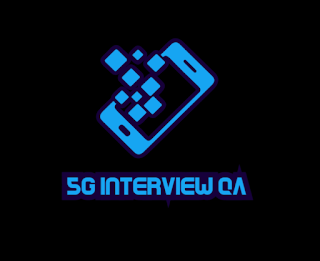6G: Introduction
1. The Evolution of Wireless Connectivity
First generation (1G):
Mobile networks were designed for voice services with data rates of up to 2.4 kbit/s. Analog signals used to transmit information, and there was no universal wireless standard.
Second generation (2G):
Was based on digital modulation techniques and offered data rates of 50 Kbit/s to 384 Kbit/s, supporting not only voice services but also data services such as Short Message Service (SMS). The flagship 2G standard was the Global System for Mobile (GSM) communications.
Third generation (3G):
Mobile networks provided data rates of at least 2 Mbit/s and enabled advanced services including web browsing, TV streaming, and video services with data rates of up to 20 Mbit/s. To achieve global roaming, 3GPP was established to define technical specifications and mobile standards.
Fourth generation (4G):
Mobile networks were introduced in the late 2010s. 4G is an entirely Internet Protocol (IP) based network capable of providing high speed data rates of up to 1 Gbit/s in downlink and up to 500 Mbit/s in uplink to support advanced applications such as digital video broadcasting. DVB), high-definition TV content and video chat. LTE-Advanced (LTE-A) has been the dominant 4G standard, integrating technologies such as coordinated multipoint (CoMP) transmission and reception, multiple-input multiple-output (MIMO), and orthogonal frequency division multiplexing (OFDM).
Fifth generation (5G):
Is to use not only the microwave band but also the millimeter-wave (mmWave) band for the first time to significantly increase data rates to 20 Gbit/s. Another feature of 5G is the more efficient use of spectrum, as measured by increasing the number of bits per Hz. ITU's International Mobile Telecommunications 2020 (IMT 2020) standard proposed the following three major 5G usage scenarios:
1. Enhanced Mobile Broadband (eMBB),
1. Enhanced Mobile Broadband (eMBB),
2. Ultra-Reliable and Low Latency Communications (URLLC),
3. Massive Machine Type Communications (mMTC).
As 5G is entering the commercial deployment phase, research has begun to focus on 6G mobile networks, which are estimated to be deployed by 2030 Typically, next-generation systems do not emerge out of a vacuum, but rather follow industrial and technological trends from previous generations. Potential research directions for 6G in line with these trends were provided by Bi (2019), which included, among others:
2. What is 6G?
6G, short for the sixth generation of wireless technology, is envisioned to provide even faster data speeds, lower latency, greater capacity, and support for advanced technologies such as artificial intelligence, virtual reality, augmented reality, and the Internet of Things (IoT). It may also include innovations such as terahertz frequency bands, massive MIMO (multiple-input multiple-output) systems, and advanced antenna techniques to enhance network performance.
● 6G will continue to move to higher frequencies with wider system bandwidth: given that the spectrum at lower frequencies is nearly exhausted, the current trend is to increase the data rate by more than 10 times for each generation to achieve wider bandwidth at higher frequencies Is:
● Massive MIMO will remain a key technology for 6G: Massive MIMO has been the defining technology for 5G which has enabled the antenna count to increase from 2 to 64. Given that performance gains have saturated in the areas of the channel coder and modulator, spectral efficiency increases for 6G in the multiple antenna area will continue to be expected. MIMO Interview Questions Answers.
● 6G will continue to move to higher frequencies with wider system bandwidth: given that the spectrum at lower frequencies is nearly exhausted, the current trend is to increase the data rate by more than 10 times for each generation to achieve wider bandwidth at higher frequencies Is:
● Massive MIMO will remain a key technology for 6G: Massive MIMO has been the defining technology for 5G which has enabled the antenna count to increase from 2 to 64. Given that performance gains have saturated in the areas of the channel coder and modulator, spectral efficiency increases for 6G in the multiple antenna area will continue to be expected. MIMO Interview Questions Answers.
● 6G will take cloud service to the next level: With consistently higher data rates, lower latency, and lower transmission costs, many computational and storage functions have been moved from smartphones to the cloud. As a result, most of a smartphone's computational power can be focused on presentation rendering, making VR, AR or XR more efficient and affordable. Many Artificial Intelligence (AI) services that are intrinsically cloud based can be more easily and widely proliferated. In addition to smartphones, low-cost functional terminals may once again flourish, providing opportunities for development in more application areas.
● Grant-free broadcasts may become more prominent in 6G: In previous cellular network generations, broadcasts were primarily based on grant-oriented designs with strong centralized system control. 6G will require more advanced grant-free protocols and approaches. It is possible that non-orthogonal multiple access (NOMA) technology may have another chance to prevail due to its low-latency performance, even if it fails to take off during the 5G time period.
● MMTC is more likely to take shape in the older generation before succeeding in the next generation: MMTC has been one of the major directions for next-generation system design since the growth of the people-to-people communication market. High hopes are pinned on 5G MMTC to deliver significant growth for the cellular industry. However, so far, this expectation has been mismatched with reality.
● Grant-free broadcasts may become more prominent in 6G: In previous cellular network generations, broadcasts were primarily based on grant-oriented designs with strong centralized system control. 6G will require more advanced grant-free protocols and approaches. It is possible that non-orthogonal multiple access (NOMA) technology may have another chance to prevail due to its low-latency performance, even if it fails to take off during the 5G time period.
● MMTC is more likely to take shape in the older generation before succeeding in the next generation: MMTC has been one of the major directions for next-generation system design since the growth of the people-to-people communication market. High hopes are pinned on 5G MMTC to deliver significant growth for the cellular industry. However, so far, this expectation has been mismatched with reality.
3. The Vision for 6G
The vision for 6G is nothing short of revolutionary. It promises data transfer rates that are several times faster than 5G, potentially reaching terabits per second. This massive increase in speed will enable real-time applications, augmented reality experiences, and seamless connectivity on a scale we've never seen before.
4. Key Features of 6G Technology
a. Terahertz Frequencies
One of the defining features of 6G is its utilization of terahertz frequencies. These extremely high-frequency bands will allow for more data to be transmitted at a faster rate, paving the way for lightning-fast downloads and ultra-responsive networks.
b. AI Integration
6G will integrate artificial intelligence (AI) in its infrastructure to optimize network management, enhance security protocols, and adapt to user behavior in real-time. AI-driven networks will be capable of self-optimization, ensuring a seamless and efficient user experience.
c. Holographic Communication
Imagine being able to communicate with a life-like hologram of a loved one from across the globe. 6G aims to make this a reality by enabling high-definition holographic communication, transcending physical boundaries and bringing people closer together.
d. Quantum Communication
6G is set to explore the potential of quantum communication, which offers unparalleled levels of security and privacy. By harnessing the principles of quantum mechanics, 6G networks can ensure that data transmission remains impervious to hacking or interception.
5. Impact on Industries and Society
a. Healthcare
In the field of healthcare, 6G's ultra-reliable and low-latency connectivity will enable remote surgeries, empowering surgeons to operate on patients located miles away. Additionally, real-time health monitoring and diagnostics will become more accessible, leading to improved patient care.
b. Transportation
Autonomous vehicles will greatly benefit from 6G's lightning-fast response times and real-time data exchange. This technology will revolutionize transportation by enhancing safety, reducing congestion, and enabling vehicles to communicate seamlessly with each other and the surrounding infrastructure.
c. Entertainment and Gaming
6G's high-speed data transfer will revolutionize the entertainment and gaming industries. Users can expect lag-free streaming, immersive virtual reality experiences, and online gaming at levels of realism never seen before.
d. Education
In the realm of education, 6G will pave the way for enhanced remote learning experiences. Interactive virtual classrooms, augmented reality textbooks, and collaborative learning platforms will become the norm, offering students from diverse backgrounds access to quality education.
6. Challenges and Considerations
Despite the promising future of 6G, several challenges need to be addressed before its widespread adoption. Some of these challenges include:
a. Infrastructure Development
To realize the full potential of 6G, a robust and extensive infrastructure must be put in place. This includes the deployment of base stations, antennas, and fiber-optic networks to support the increased data demands.
b. Spectrum Allocation
As 6G incorporates terahertz frequencies, careful spectrum allocation is essential. These high-frequency bands have limited range and can be affected by environmental factors, requiring strategic planning to ensure consistent coverage.
c. Security and Privacy Concerns
With increased connectivity and AI integration, security and privacy become critical concerns. 6G networks must implement robust encryption and authentication mechanisms to protect user data and thwart potential cyber threats.
7. The Road to 6G
While 6G technology is still in its infancy, researchers, technology companies, and governments worldwide are already investing heavily in its development. Collaborative efforts and innovation will pave the way for 6G's eventual commercialization and integration into our daily lives.







